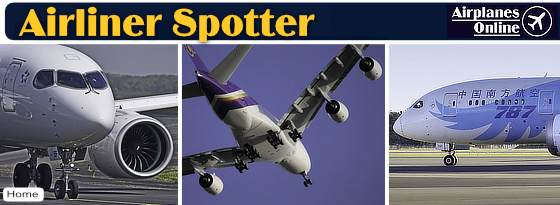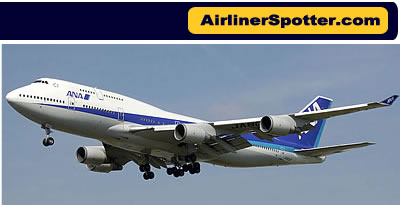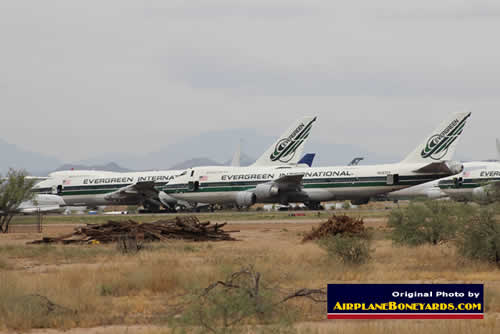Boeing 747 Spotting Guide
The Boeing 747 is a wide-body, 4-engine commercial jet airliner and cargo aircraft, often referred to by its original nickname, Jumbo Jet, or by a more popular term today "Queen of the Skies".
Its unique "hump" upper deck along the forward part of the aircraft makes it among the world's most recognizable aircraft, and it was the first wide-body produced. The hump on the front third of the fuselage was designed to house the cockpit and a first class lounge.
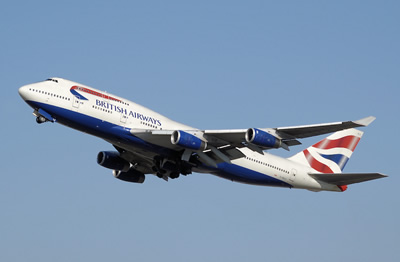 Boeing 747 of British Airways |
Manufactured by Boeing's Commercial Airplane unit in the United States, the original version of the 747 was envisioned to have 150% greater capacity than the Boeing 707.
The upper deck of the initial 747-100 series had three widely-spaced windows on each side of the fuselage; on the port side there was a small emergency door, located just aft of the cockpit window.
The 747-200 model was introduced into service in 1971, featuring more powerful engines and a higher MTOW. Passenger, freighter and combination passenger-freighter versions of the -200 were produced.
The 747 family was further enhanced with the launch of the 747-300 which featured a stretched upper deck which included two additional emergency exit doors.
The -300 was followed by the 747-400 in 1989, which retained the stretched upper deck design. The Boeing 747-400 is similar to the 747-300, but distinguished by its winglets.
A total of 1,573 747s had been built at the end of production.
Delta Air Lines and United Airlines both retired the last 747s in their fleets in late 2017 and early 2018 (see video below).
Boeing 747 Background and Development
The four-engine 747 uses a double deck configuration for part of its length. It is available in passenger, freighter and other versions. The 747 is supported by 18 wheels, two on the front landing gear, and 4 "bogies'" of 4 for the main landing gear, 2 under the fuselage, and one located under each wing.
The 747 design team of 4,500 Boeing engineers was led by the legendary Joe Sutter, the "Father of the Boeing 747", who died at age 95 in 2016. A World War II veteran of the U.S. Navy, Sutter's degree in Aeronautical Engineering served him well in multiple roles at Boeing.
Joe also worked on the Boeing Dash-80, 720, 727 and 737 projects before leading the 747 team.
In April of 1966, Pan American World Airways became the launch customer of the wide-body airliner by ordering 25 of the 747-100 models for $525 million. Pan Am President Juan Trippe was a strong advocate for a larger airliner than the 707.
The 747 entered service in January of 1970 on Pan Am's New York–London route.
| Boeing 747 rollout on September 30, 1968, at the Boeing plant in Everett, Washington |
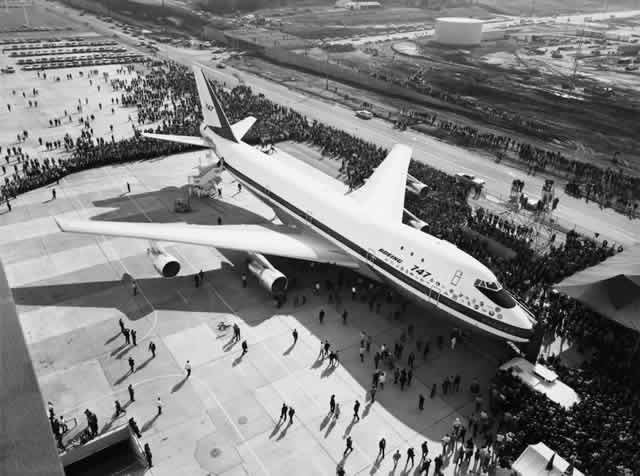 |
Boeing displayed a 747 for the first time at the Paris Air Show in 1969. In January of 1970 Pan Am took delivery of its first 747, christened "Clipper Victor" by First Lady Pat Nixon. The inaugural 747 flight occurred the same month, flying from New York to London.
Boeing 747 Spotting Guide
| The wide-body Boeing 747 is an easy spot with its bulbous front fuselage, four engines under the wings, one full deck the length of the fuselage, and one partial deck on the front. |
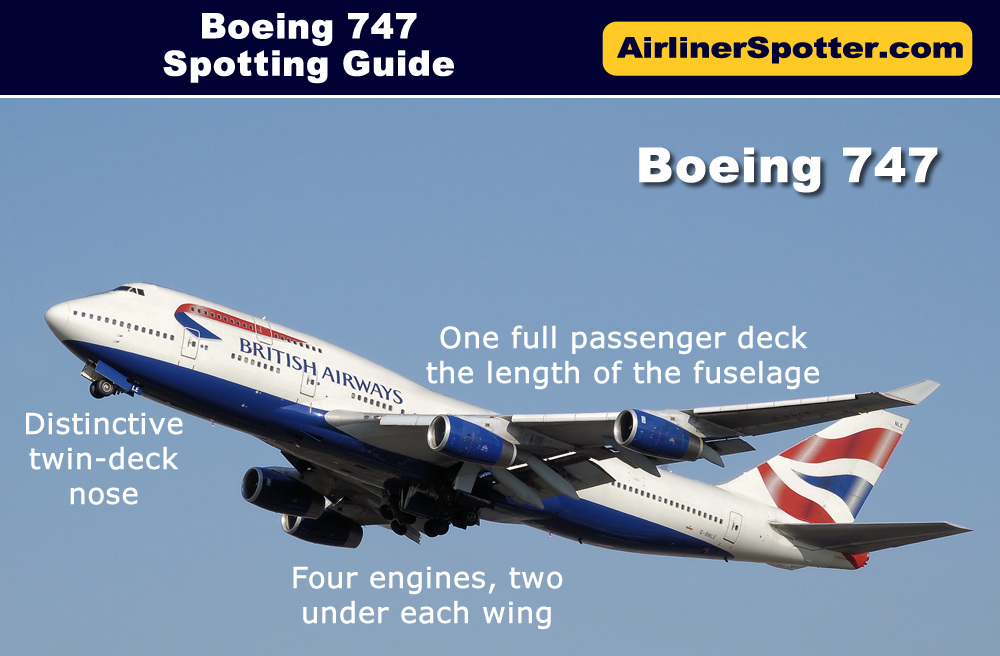 |
| Shown below is a side-by-side comparison of the Boeing 747-8F to the Antonov An-124-100, both wide-body jet freighters with four engines. Also shown is the similar designed Lockheed C-5 Galaxy. |
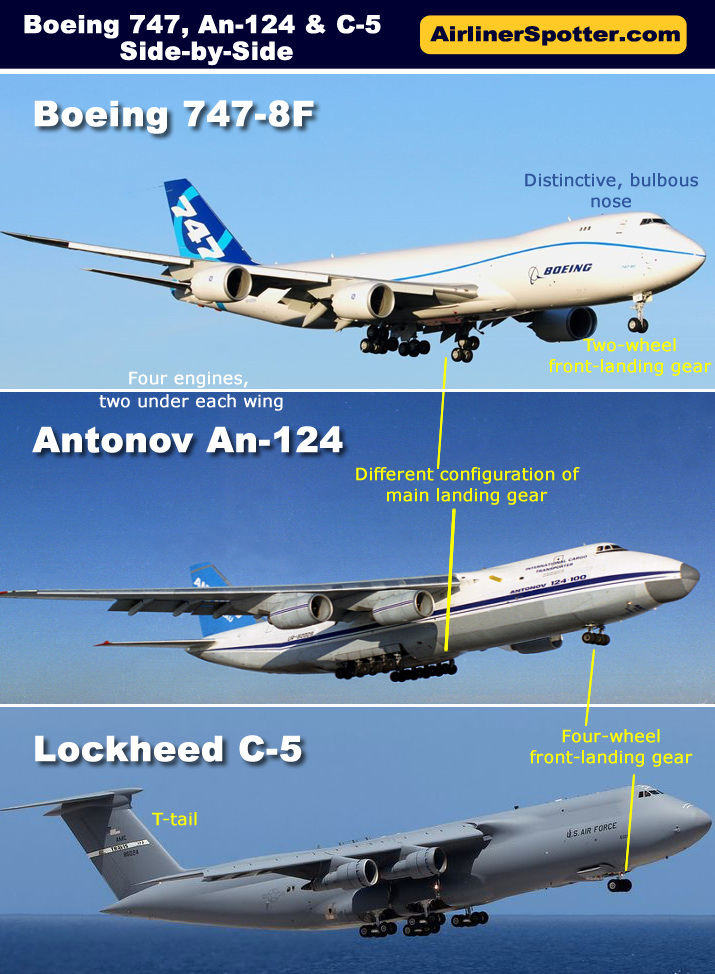 |
747-100 & Early Variants
The upper deck of the -100 series had three widely-spaced windows on each side of the fuselage; on the port side there was a small emergency door, located just aft of the cockpit window.
The -100 was 225 feet in length with a winspan of 196 feet.
After the initial 747-100 model, Boeing developed the -100B, a higher maximum takeoff weight (MTOW) variant, and the -100SR (Short Range), with higher passenger capacity.
Early 747-100 aircraft had three windows on each side of the upper deck, but later some -100 models featured a ten-window configuration. And some ten-window models had some of the windows "blanked out".
| The first Boeing 747-121, the "City of Everett", now on display at the Museum of Flight in Seattle, Washington (Staff Photo) |
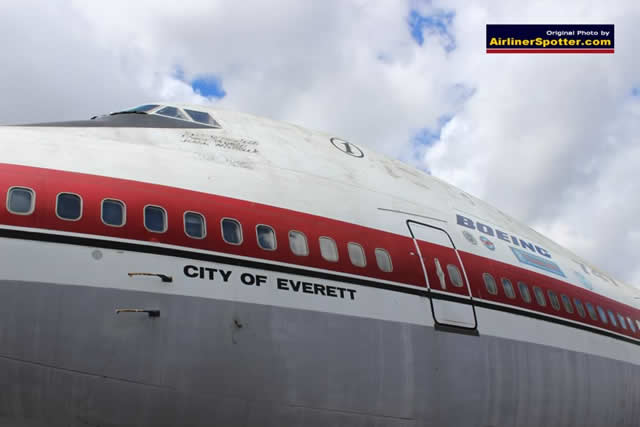 |
Boeing 747SP
The shortened 747SP (Special Performance) with a longer range entered service in 1976.
| Bahrain Air Boeing 747SP (Special Performance) identified by its short fuselage and large tail |
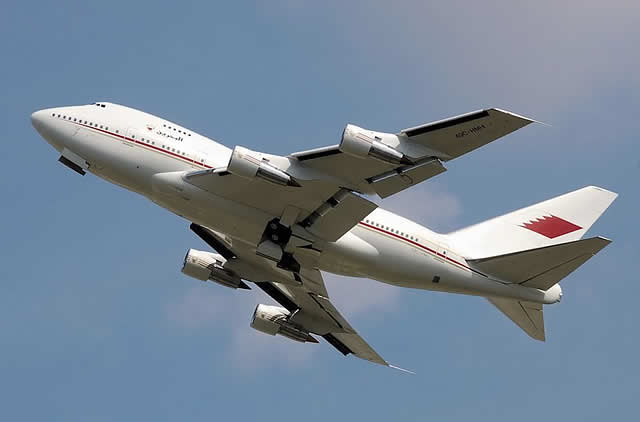 |
Boeing 747SP, Registration VP-BAT, of the Qatar Emiri - 2012 (Photo by DELEHELLE Eric) |
 |
Boeing 747SP, Registration VP-BAT, of the Qatar Emiri - 2012 (Photo by DELEHELLE Eric) |
 |
747-200
The 747-200 model was introduced into service in 1971, featuring more powerful engines and a higher MTOW. Passenger, freighter and combination passenger-freighter versions of the -200 were produced.
Many 747-200 (but not all) have 10 windows on each side of the upper deck; some were built with only 3 widely spaced windows.
| Lufthansa Boeing 747-230 ... most had 10 windows on the upper deck |
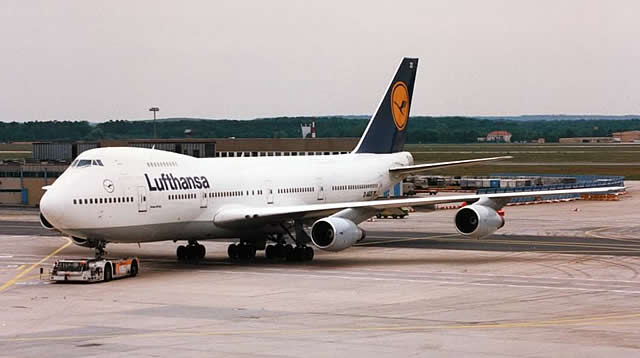 |
Boeing 747-300
The 747 family was further enhanced with the launch of the 747-300 which featured a stretched upper deck which included two additional emergency exit doors. The stretch allowed for more windows on the upper deck, usually around 20 but the exact number varied by airline.
The maiden flight was in 1982. Swissair introduced the -300 model in 1983, followed by Japan Airlines. Production totaled about 81 aircraft.
Boeing 747-300 of Pakistan International Airlines (AP-BFW) on the approach to London (Heathrow) Airport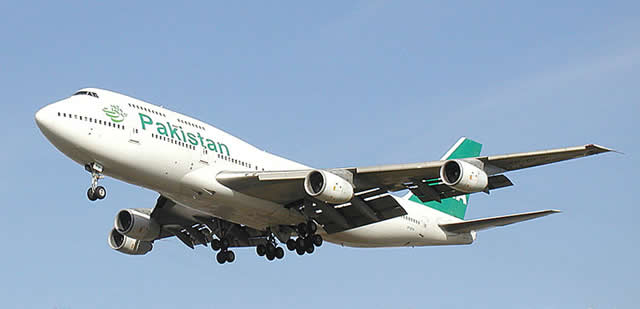 |
Boeing 747-400
The -300 was followed by the 747-400 in 1989, which retained the stretched upper deck design. The Boeing 747-400 is similar to the 747-300, but distinguished by its winglets. It also featured new control systems, avionics, air conditioning and other improvements.
Northwest Orient introduced the -400 in 1989, followed by United, British Airways, Singapore Airlines, and Lufthansa in 1990.
The -400 is the most successful model of the 747 family, with more than 690 delivered.
| All Nippon Airlines Boeing 747-400, similar to the 747-300, but distinguished by its winglets |
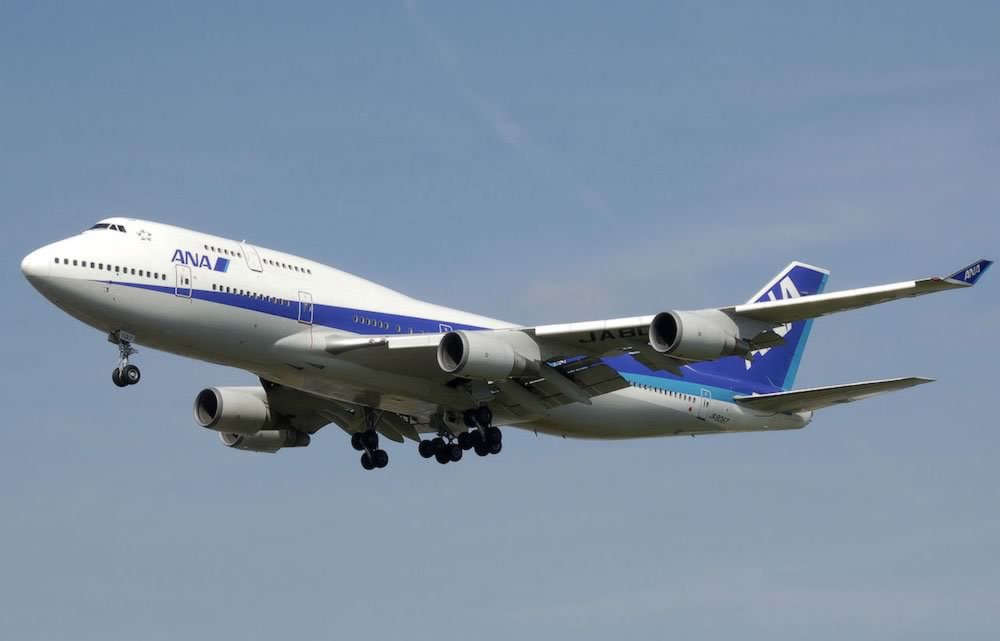 |
National Boeing 747-400, Registration N919CA - 2018 (Photo by DELEHELLE Eric) |
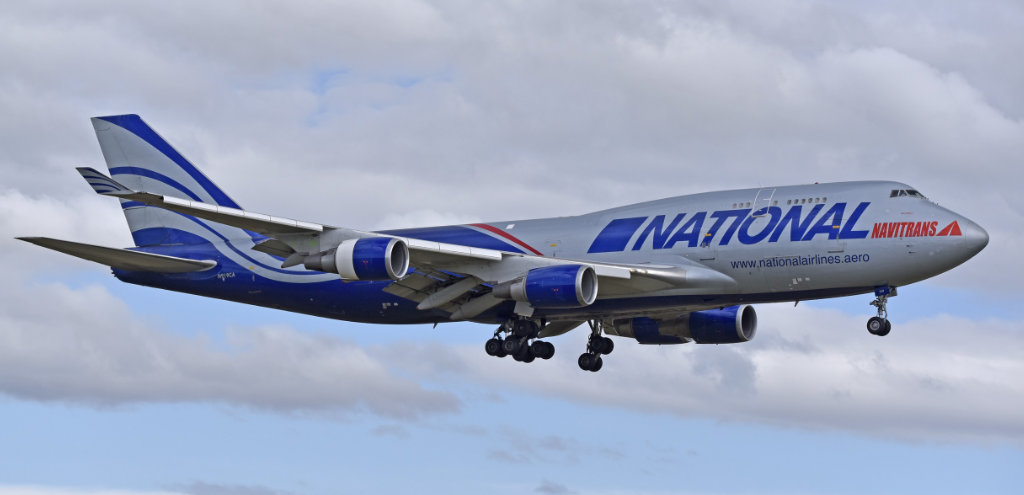 |
Boeing Dreamlifter
Boeing modified four used 747-400 aircraft into Dreamlifter large cargo freighter (LCF) planes. These are used to ferry 787 Dreamliner fuselages, wings and other parts from around the world to Boeing assembly plants in Seattle and Charleston, South Carolina.
The Dreamlifter's length is 235 feet, with a wingspan of 211 feet. Its range fully loaded is 4,800 miles.
Atlas Air has operated the Boeing Dreamlifter fleet under contract from Boeing since 2010.
A list of Dreamlifters is included below, along with registration numbers, construction numbers, line numbers and information about initial delivery dates and registrations.
| Registration | CN/MSN | Line No. | Comments |
| N249BA Boeing 747-409 |
24309 | 766 | Delivered to China Airlines 2/8/1990, previously registered as B-161 and B-18271 |
| N718BA Boeing 747-4H6 |
27042 | 932 | Delivered to Malaysia Airlines and registered as 9M-MPA on 8/27/1992 |
| N747BC Boeing 747-4J6 |
25879 | 904 | Delivered to Air China and registered as B-2464 on 3/20/1992 |
| N780BA Boeing 747-409 |
24310 | 778 | Delivered to Air China and registered as B-162 on 3/27/1990, later B-18272 |
Boeing Dreamlifter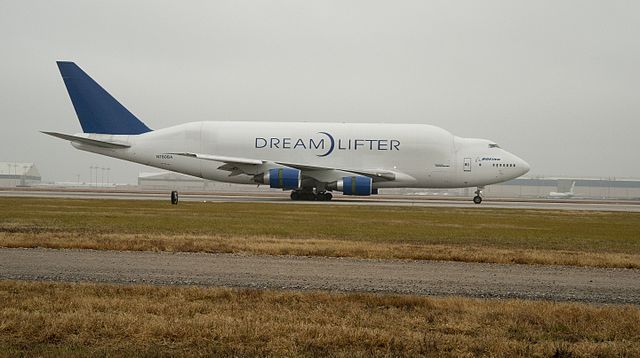 |
Boeing 747-8F and 747-8I
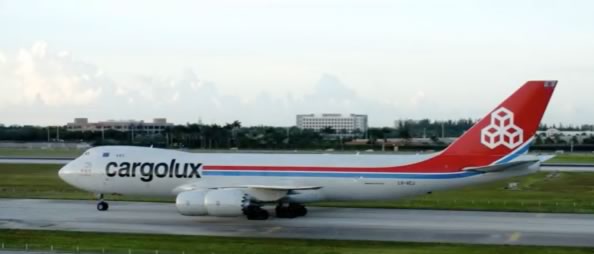 CargoLux Boeing 747-8F CargoLux Boeing 747-8F |
Boeing announced another 747 variant, the 747-8, in late 2005. Referred to as the 747 Advanced prior to its launch, the 747-8 uses the same engine and cockpit technology as the Boeing 787, hence the use of the "8" in the model number.
Models include the 747-8I (Intercontinental) and 747-8F (Freighter).
The 747-8 is 18.3 feet longer than the 747-400, with a total length of 250 feet, making it the world's longest airliner. It also features a redesigned wing, raked wingtips, sawtooth engine nacelles for noise reduction, and extra fuel capacity.
The 747-8F features a shorter upper deck than the 747-8I, with three windows, while the 747-8I has a longer upper deck with an emergency exit and up to 26 windows on each side of the fuselage.
Major orders for the 747-8F in 2016 included United Parcel Service (UPS) and Volga-Dnepr.
The Last 747
The final 747, N863GT, was delivered to Atlas Air in late January of 2023. Its flight was from Seattle Paine Field to Cincinnati. This ended the 54-year production run of the Queen of the Skies, with 1,574 aircraft built. Boeing and Atlas paid tribute to Joe Sutter, known as the "Father of the Boeing 747" and one of the chief engineers of the Boeing 747 program, with markings on the fuselage of the aircraft.
| Shown below is a spotting guide comparing the Boeing 747-8I with the 747-8F |
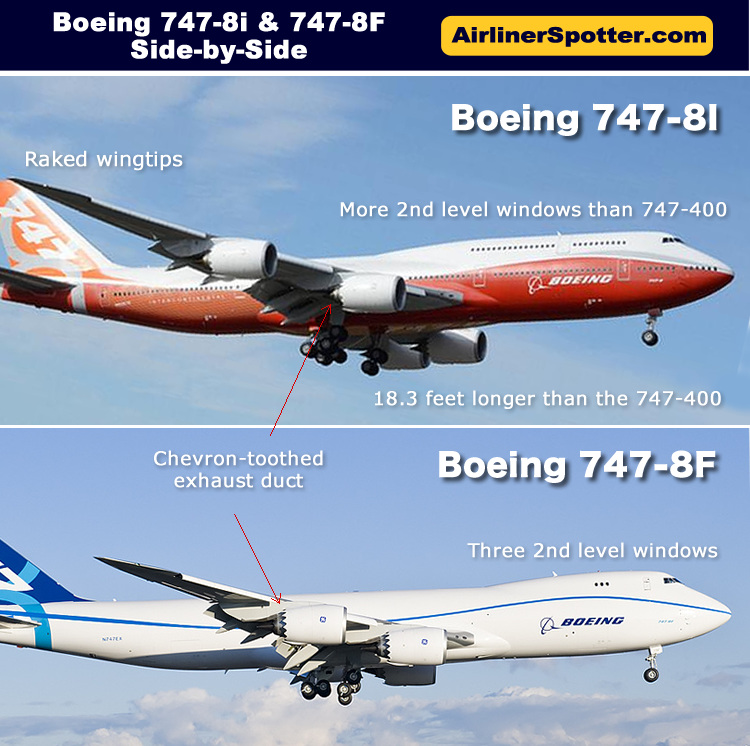 |
Boeing BBJ 747-8i, Registration VQ-BSK, Qatar Amiri Flight, seen here in 2016 (Photo by DELEHELLE Eric) |
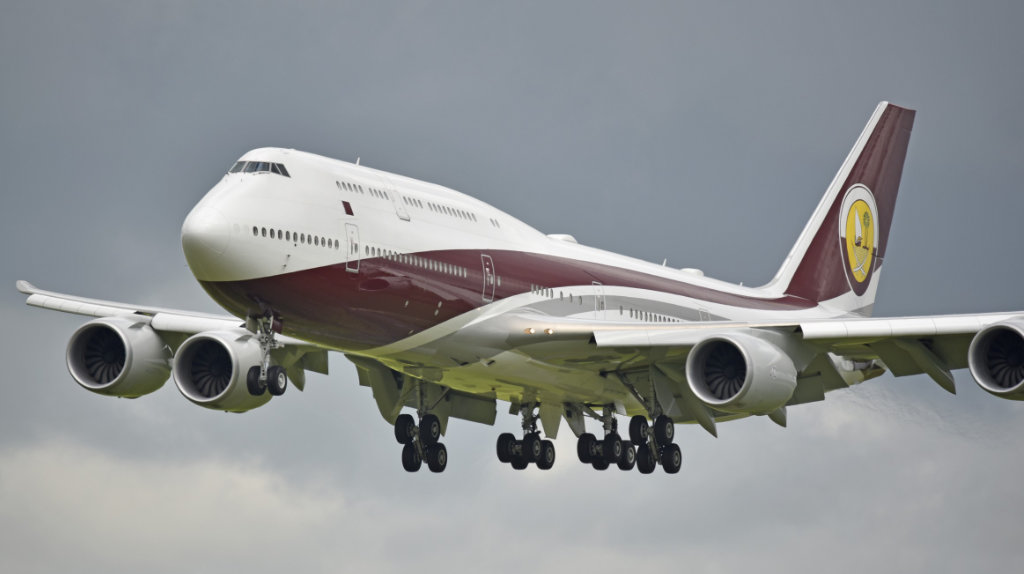 |
Landing gear and GE engines of Boeing BBJ 747-8i, Registration VQ-BSK, Qatar Amiri Flight (Photo by DELEHELLE Eric) |
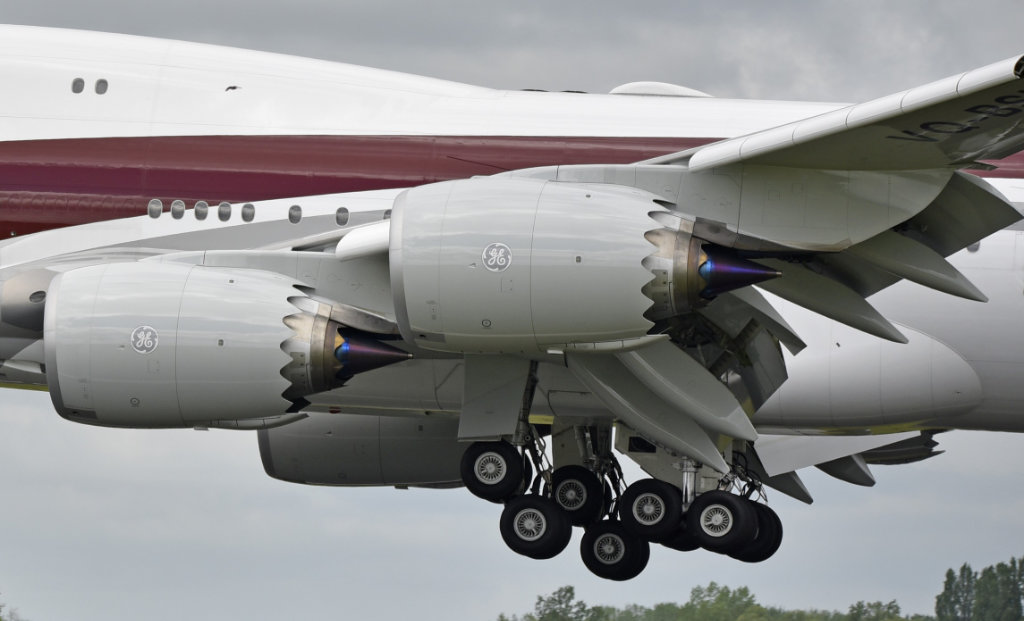 |
Boeing 747 vs the Airbus A380Boeing and Airbus both feature wide-body jumbo airliners in their product line. Here is a side-by-side view showing how to distinguish the Boeing 747 (top) and Airbus A380 (below). |
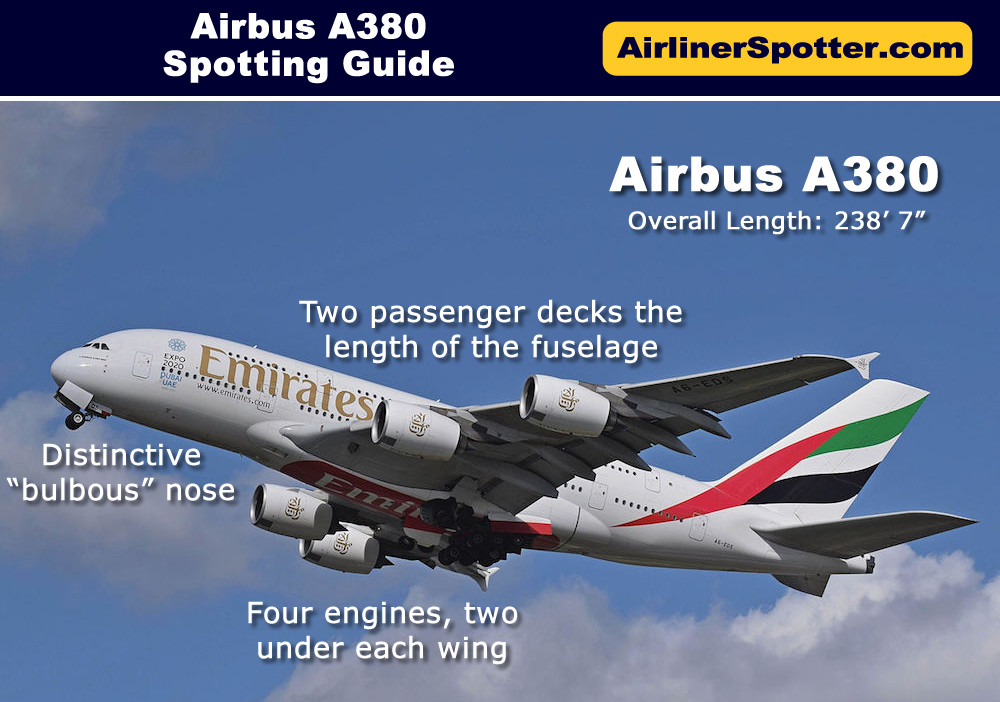 |
 |
U.S. Air Force VC-25A, Air Force One, a Boeing 747 Variant
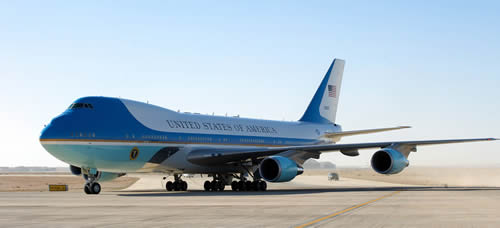 USAF VC-25A used as Air Force One |
The U.S. Air Force operates a pair of Boeing 747-200B jets modified for use by the President of the United States as Air Force One. These aircraft are identified as the Boeing VC-25A, with tail numbers 28000 and 29000 (see U.S. Air Force photos below).
The VC-25 can fly 7,800 miles without refueling, although it can be refuelled in flight. The aircraft is 232 feet long with a wingspan of 196 feet. Maximum speed is 630mph.
The aircraft are based at Joint Base Andrews in Maryland, and operated by the U.S.Air Force Air Mobility Command, 89th Airlift Wing, Presidential Airlift Group.
On order now are two new aircraft replacements for use as Air Force One, both a modified 747-8.
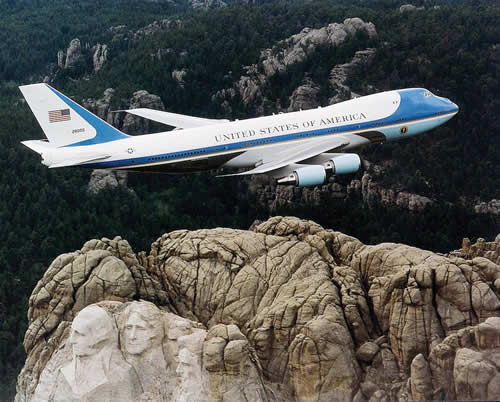 |
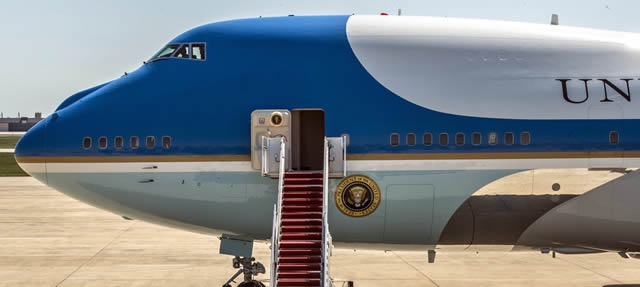 |
| Qatari Boeing B747-8 ... Possibly the next Air Force One? (Photo by Mark Bess - Flickr) |
 |
Boeing 747-100 Supertanker
| Boeing 747-132 Evergreen Supertanker, Registration, N479EV, 2009 (Photos by DELEHELLE Eric) |
|
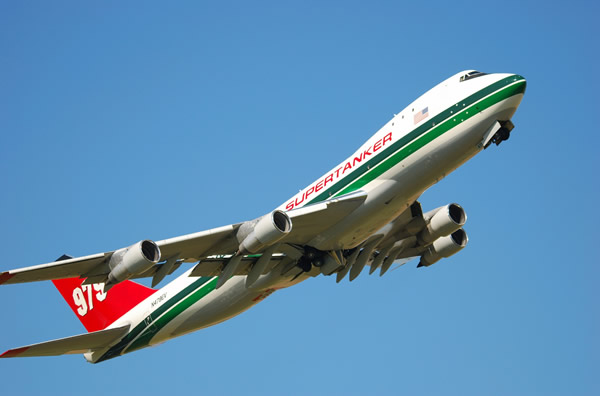 |
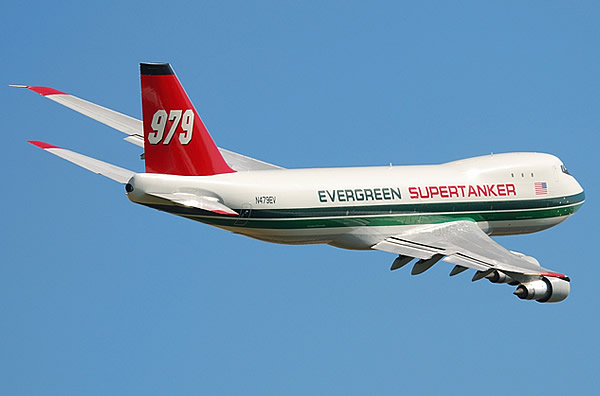 |
Photos of Boeing 747 Cargo Jets (By DELEHELLE Eric)
| Air Bridge Cargo Boeing 747-400F, Registration VQ-BHE |
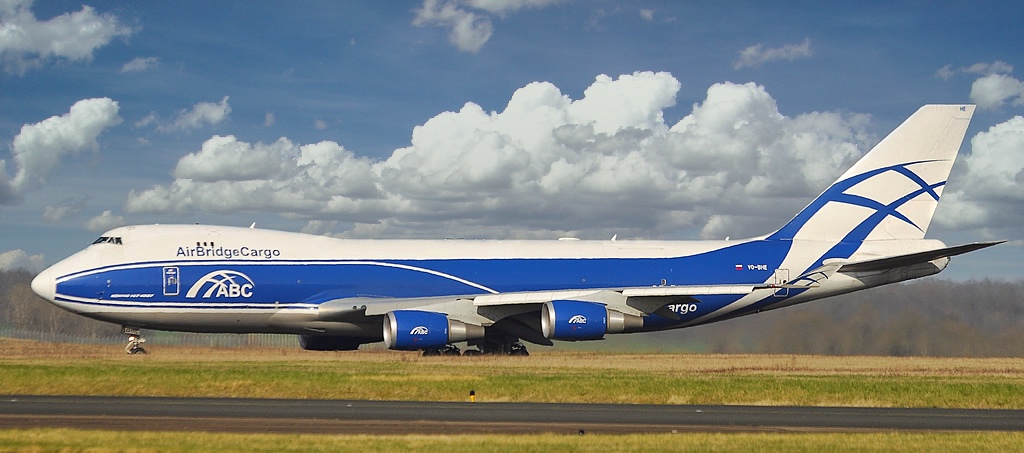 |
| Boeing 747-4HQF of Kalitta Air, Registration Number N782CK |
 |
| Boeing 747-400F of Air Cargo Global |
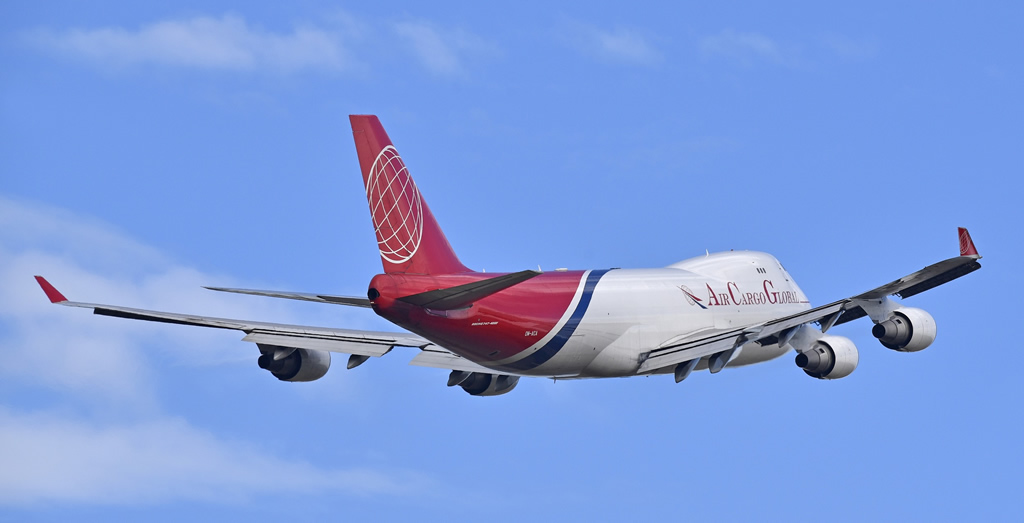 |
| Boeing 747-400F of CargoLogic Air, Registration Number G-CLAA |
 |
| Boeing 747-400 of Air Cargo Germany, Registration D-ACGB |
 |
| Astral Boeing 747-4h6, Registraiton TF-AMM |
 ASTRAL TF-AMM.jpg) |
| Boeing B747-47 of Atlas Air, Registration Number N498MC |
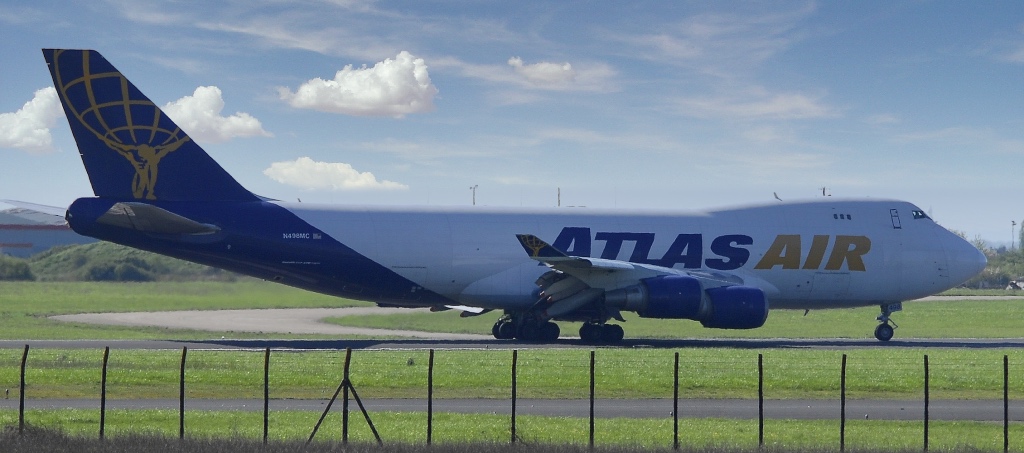 |
Boeing 747s Parked at Aircraft Storage Facilities & Boneyards
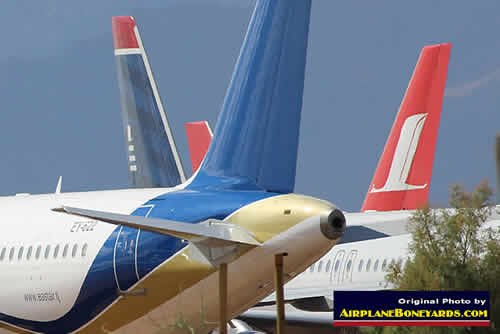 Jetliners in storage at the Phoenix Goodyear Airport in the Arizona desert
(Staff photo) Jetliners in storage at the Phoenix Goodyear Airport in the Arizona desert
(Staff photo) |
Commercial airliners have limited lifespans, even the mighty Boeing 747 jumbo jet. Ultimately, they must be retired from service, stored in "airplane boneyards" or graveyards, and finally dismantled and scrapped.
Jetliners eventually reach end-of-life due to airframe wear and/or obsolescence. Some jetliners are temporarily taken off flying status, and must be stored in a environment that is conducive to preservation. Others are kept for spare parts for flying aircraft.
To protect airliners during their storage from wind and sun damage, engines and windows are tightly covered with white, reflective materials. A sealed airliner can thus be stored safely, for years, until the time comes to return it to active duty, or salvage. Eventually, all airliners are removed permanently from service and must be "disposed" of.
We have spotted and photographed a variety of Boeing 747s at several airline boneyards in the western United States, including:
- Mojave Airport in California
- Southern California Logistics Airport (SCLA) in Victorville, California
- Pinal Airpark near Tucson, Arizona
- Phoenix Goodyear Airport in Arizona
Also included is information on airplane boneyards in Europe, Australia and other locations around the world.
![]() ... and view photos of commercial airliner boneyards at www.AirplaneBoneyards.com
... and view photos of commercial airliner boneyards at www.AirplaneBoneyards.com
| Boeing 747-121 of GE Aircraft Engines, registration number N747GE, parked at the Southern California Logistics Airport near Victorville, CA (Staff Photo) View similar photos at AirplaneBoneyards.com |
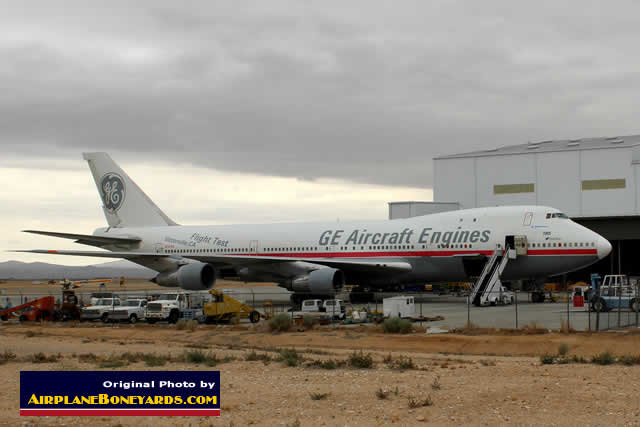 |
| Boeing 747-312 (F-GSKY) parked at the Phoenix Goodyear Airport in Arizona (Staff Photo) View similar photos at AirplaneBoneyards.com |
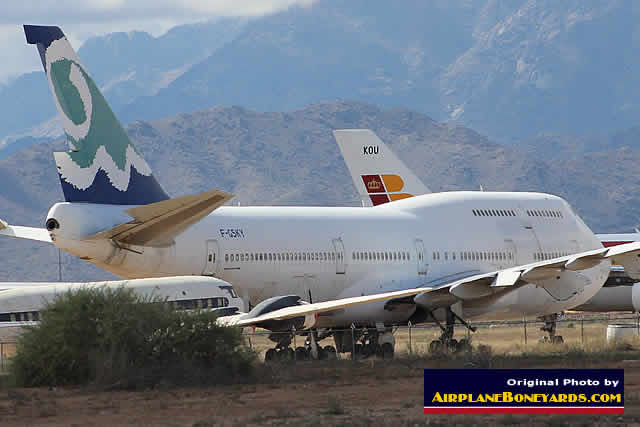 |
Evergreen International Boeing 747s at the Pinal Airpark near Tucson, Arizona (Staff Photo)
|
YouTube Video of Boeing 747 Takeoffs (Courtesy of PilotSanderHD)
